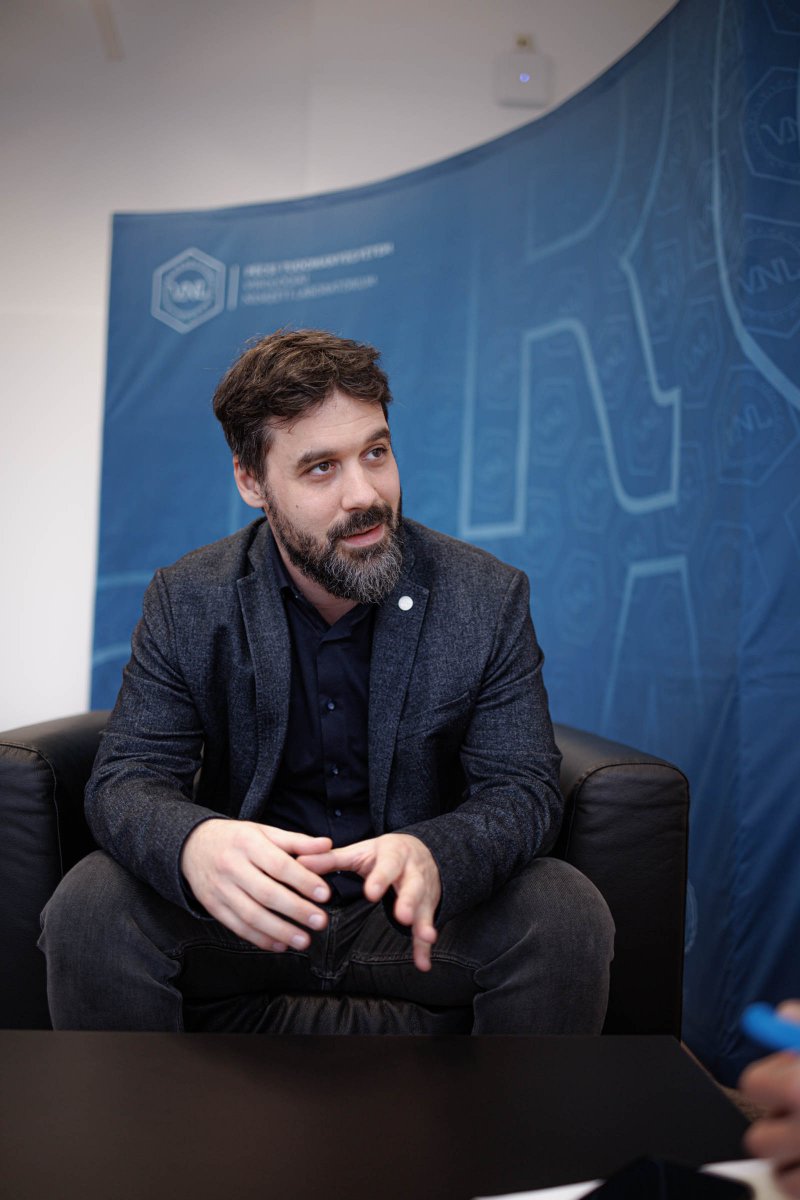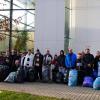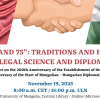"There are no limits for viruses"
2024
Nov
26
In February, Dr. Gábor Kemenesi, Associate Professor, took over the leadership of the National Laboratory of Virology (VNL) of the University of Pécs, continuing the work of his mentor, Professor Ferenc Jakab. I asked the renowned virologist about the current and future projects of VNL and the upcoming annual meeting of the Balkan Association for Vector-Borne Diseases.
You took over the leadership of VNL in the first half of the year. What has happened since then?
The development of VNL has started, which also means a huge institutional development activity. Not only are we appointing directors, deputy directors, research teams and team leaders, but we are also starting to put in place a  structured mentoring culture that has been in place since the beginning - something we are very proud of and which sets us a little apart from the national labs. All this makes internationalisation, innovation, patent applications, publications - in other words, all kinds of operations - more efficient. As a project institution, this was a major challenge for us, which we have been able to leapfrog and which has led to exponential growth of the lab in recent times. We are involved in an increasing number of tenders and collaborations from the Americas to Bangladesh and the Balkans to China, and we have two major international events in November. All this shows that institutional development was needed to put us more visible on the international map.
structured mentoring culture that has been in place since the beginning - something we are very proud of and which sets us a little apart from the national labs. All this makes internationalisation, innovation, patent applications, publications - in other words, all kinds of operations - more efficient. As a project institution, this was a major challenge for us, which we have been able to leapfrog and which has led to exponential growth of the lab in recent times. We are involved in an increasing number of tenders and collaborations from the Americas to Bangladesh and the Balkans to China, and we have two major international events in November. All this shows that institutional development was needed to put us more visible on the international map.
It was also a very important and personal goal of mine to ensure that our mentoring culture, which is our greatest strength, did not suffer in the process. We want everyone who comes here to feel that this is not a workplace where you walk in and walk out, but a home that when you walk out, you think of it as home.
How should this be imagined in practice?
During the application process, we do not only guide the students, we also mentor them, working in a mentor-student relationship. We try to actively involve them in the life of the lab and bring them into interaction with the others, to see how well they fit in, how open they are, and where necessary, to support and nudge them, as in a family.
After the Civid-19 pandemic, the public interest in you has waned, even though work has not stopped for a minute. What are you doing now?
Our main focus is on epidemic prevention, in a broad perspective anything that poses an epidemic risk. We now have a world-renowned BSL-4 level laboratory, which allows us to work with viruses of high infectivity (pathogenicity). This has allowed us to make our mark in the international portfolio, but we also needed luck to stand out even there.
We have research directions - and these are the ones that make us most visible in the world - that deal with filoviruses, such as Ebola or Marburg, which have a relative in Europe.
On the one hand, we are dealing with this virus and, by understanding it, we are trying to answer questions about Ebola and Marburg in Africa that have not been answered in the last 50-60 years. These are also bat-related, but would be much more difficult to study in an African jungle.

We are currently in discussions with the World Health Organization, the European Centre for Disease Control and the Rwandan authorities,
who have recently asked us to help them identify the caves that could have been the source of the latest Marburg outbreak and to map which caves could be the source of the next outbreak. There are only two research groups in the world that deal with bats and highly pathogenic viruses, one is the US Centers for Disease Control (CDC) and the other is ours.
This year we lost two important and internationally renowned members of the Hungarian virology community, Ferenc Jakab and István Jankovics. The latter always said that
this work is never over, because if a new pendemic is not knocking on the door of Hungarian families, it is somewhere else in the world.
As a non-specialist, what should you look out for when you hear in the media that the WHO has issued a warning about a virus in Europe?
In layman's terms, there are two things to understand. One is that there are no limits to viruses! That is why it is best to treat and eliminate any outbreak at the source, regardless of the virus. The second is that there is a big difference between a virus and a virus. It is important to be aware that our world is vast and very diverse, which is especially true for viruses. That is why their research is hard and endless work, they always have something new to show us. I have a third warning: never be afraid. And what is the best cure for fear? Knowledge! Understand what is happening. Let's look for it! Not in Google searches or Facebook groups, but through the channels of science. Researchers, scientists are there to help you with this, they can explain what the emergence of a particular virus is all about.

You have several international events coming up in November, what's worth knowing about them?
Somehow, the Iron Curtain effect has remained in science, with the partnership network of most EU grants, mainly stopping 99% of the time in Austria. The EU has also recognised this in recent years, and has launched several structural tenders targeting other regions, there are Africa-specific, South Asia-specific, etc.
The Balkan bloc is full of extraordinary resources, professionals, rich in expertise and, in some places, infrastructure. Over the past two years, we and several partners have recognised that this could be leveraged, and we have set up an organisation, the Balkan Association for Vector-Borne Diseases (BAVBD), which was established to address vector-borne diseases.
The reason for this is that the greatest infectious disease risk and future for Europe comes from arthropods with a variety of bite properties: ticks, humpback mosquitoes, moths, midges.

The Balkans conference will feature international speakers, as a way of trying to get into the European bloodstream. And we brought it to Pécs because, as a member of the EU, the Szentágothai Research Centre - as an extremely well-equipped facilitator - can be a very good mediator and centre in this whole organisation, where we lead the diagnostic laboratory action group. What we want to achieve with this conference is to make it more visible in the West that we are here, we are open and we are here as one. If someone would work with us, they can work with this whole bloc.
These professionals see the reality of what a Crimean-Congo hemorrhagic fever outbreak looks like when it spreads a vector tick. With the right resources, we can attract and retain these professionals and with their help, we can build a knowledge base and resources to effectively manage these outbreaks.
We have several infectology clinics, the Pasteur Institute in Novi Sad, large research institutes, hospitals and universities in our organisation, which has allowed us to submit several tenders where we are not a multiple partner, but a main applicant. We try to be a force and attract resources.

In northern Macedonia, for the first time in fifty years, there have been patients with Crimean-Congo haemorrhagic fever. We don't want it to appear in Hungary, but Hungary is preparing for it, as it has its range on our southern border and the tick that spreads it is moving north with the dry, hot summers. It shows the strength of BAVBD that we have been approached for help through it, because our BSL-4 level laboratory, experienced with this virus, is capable of investigating the outbreak. We have had a very good, real outbreak investigation success involving biologists, veterinarians, clinicians, we have involved Serbian colleagues and we have already had two publications. We have been able to get all the clinics in northern Macedonia to pay attention to this disease, so that in many cases it turns out that this virus is already present. This helps us to prepare for the spread of this virus. If there is an outbreak in countries to the south of us, we can help to eradicate it with these capacities that we have built up.
What would you highlight in your plans for the future?
 I look at this Eastern bloc as the global southern section of Europe, because although we've been a bit forgotten, we have a big advantage here, because we're between the West and the East, and we can balance it in the middle. We're also working on a French-Chinese-Hungarian collaboration, which is also related to a research project on bats, and again our lab is a big advantage. This again shows how well positioned we can be if we channel our skills well. If we talk about what's happened since February, for example, this is that we've had quite a lot of success in channelling, and we're now seeing the results of that. I have an extremely busy day, with one international meeting after another, but it is definitely a good sign in the life of a researcher, because it shows that good things are happening.
I look at this Eastern bloc as the global southern section of Europe, because although we've been a bit forgotten, we have a big advantage here, because we're between the West and the East, and we can balance it in the middle. We're also working on a French-Chinese-Hungarian collaboration, which is also related to a research project on bats, and again our lab is a big advantage. This again shows how well positioned we can be if we channel our skills well. If we talk about what's happened since February, for example, this is that we've had quite a lot of success in channelling, and we're now seeing the results of that. I have an extremely busy day, with one international meeting after another, but it is definitely a good sign in the life of a researcher, because it shows that good things are happening.
Originally written in Hungarian by Martina Aknai-Kiss
Translated by Mercédesz Kovács-Csincsák
- Log in to post comments
University of Pécs | Chancellery | IT Directorate | Portal group - 2020.






















